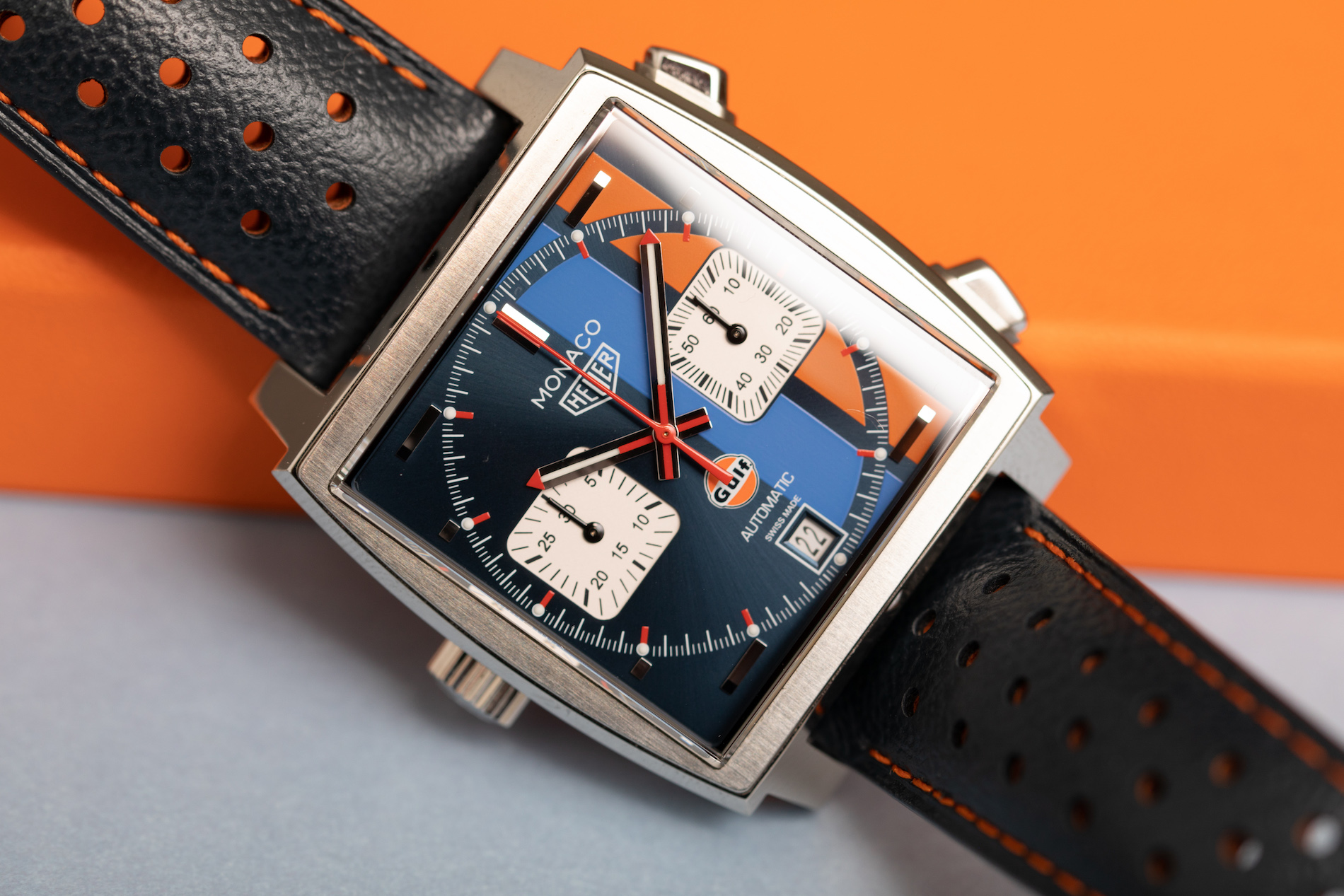
The latest iteration of the TAG Heuer Monaco Gulf watch was introduced last year to celebrate the 50th anniversary of the relationship between the brand and Gulf racing. My time with the watch led to the realization that it very well may be my favorite Monaco of all. I spent a few weeks with the awesome, classic blue dial Monaco last year at the eponymous Grand Prix. A decade since the last Monaco Gulf and the design plus calibre 11 movement is a winner. TAG Heuer charges no premium for the Gulf edition over the standard calibre 11 ($5,900) which further affirmed my adoration.
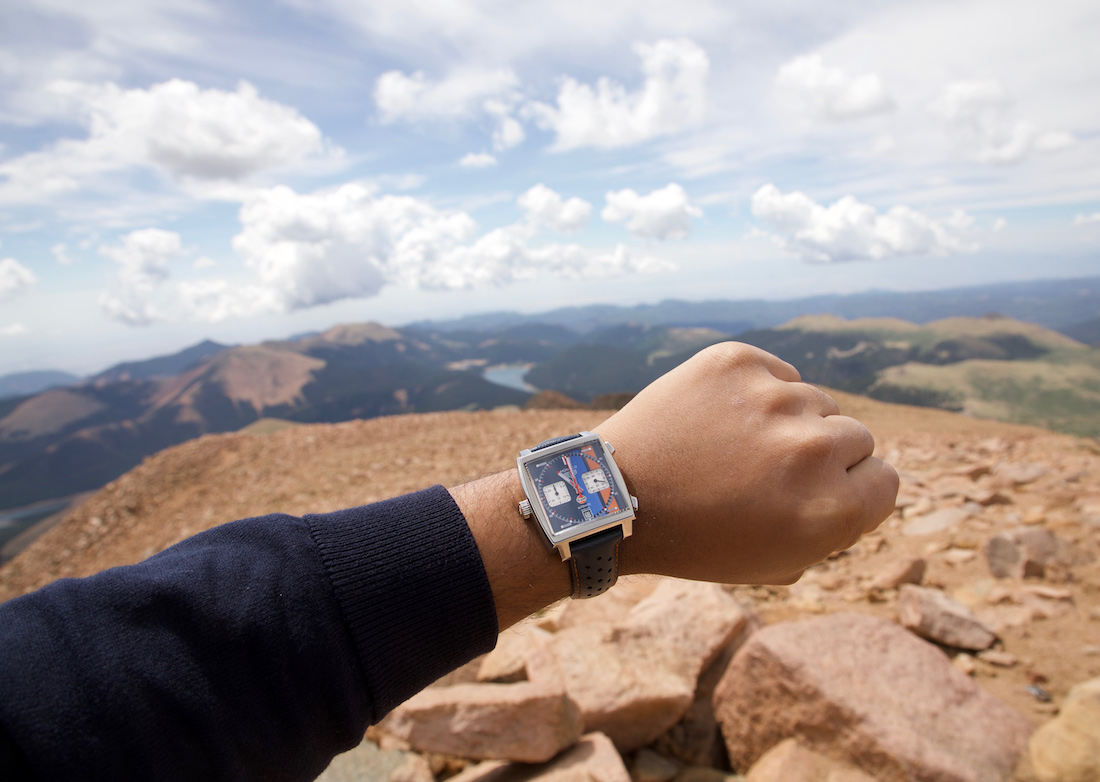
TAG Heuer Monaco Gulf Explained
I have to say that while I’d definitely personally prefer this Monaco Gulf, I was really happy to see the forged carbon Bamford edition (haters to the left) released earlier this year at Baselworld. TAG’s confidence in the versatility of the Monaco style comes through in the coexistence of these very different interpretations.
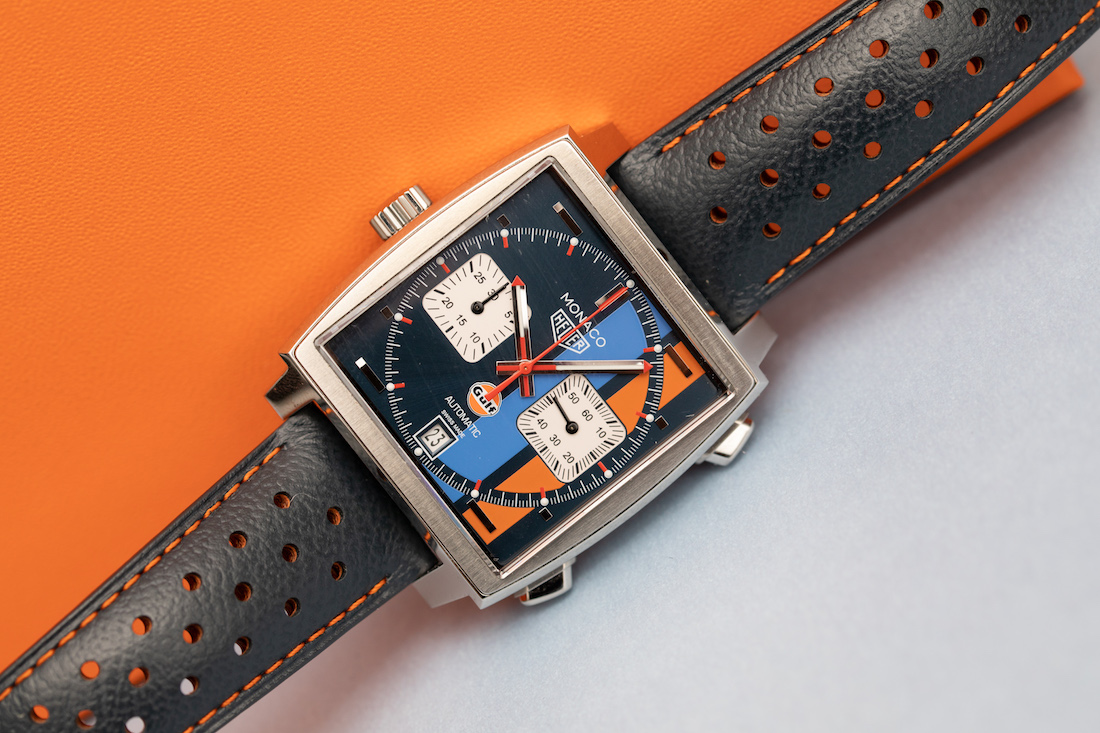
Since this newest Monaco Gulf watch is only stylistically different from the standard TAG Heuer Monaco calibre 11, I want to spend some time going through the evolution of the Gulf Monaco so everyone can understand its context, evolution, and history. Special thanks to TAG Heuer history aficionados Calibre 11 who outlined the history of these watches which you can check out here.
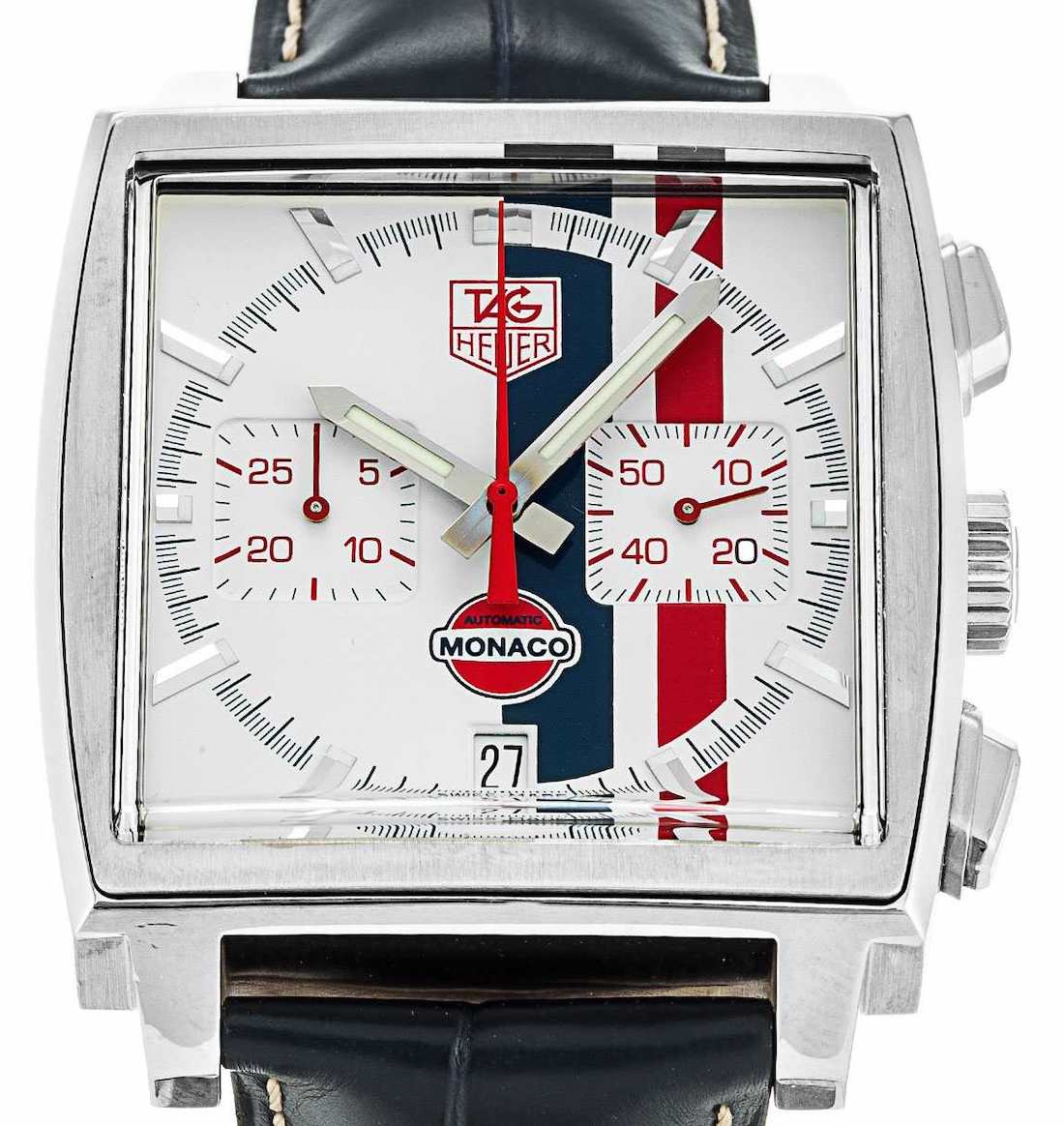
TAG Heuer Monaco Gulf ’Vintage’ ref. CW2118 & ref. CW211A (2005-2007)
This Monaco Gulf celebrates the 50th anniversary between TAG and Gulf, the first Gulf Monaco came out in 2005. The TAG Heuer ‘Vintage’ Monaco reference CW2118 was a limited edition run of 4,000 watches with a white dial featuring red and blue stripes. These were inspired by the colors of Steve McQueen’s racing suit in Le Mans. The release in 2005 also coincided with McQueen’s 75th birthday.
Like with all Gulf Monacos before this latest model, the crown is on the case left alongside the chronograph pushers. It was, the only Monaco without “Gulf” on the dial (read the Calibre 11 article for details). This model has the modified-ETA calibre 17 movement housed in the smaller 38mm x 38mm, 13mm thick case. While it was a limited edition run, it’s not super difficult to find one of these on the secondary market (here are the current listings on Chrono24) ranging between around $3,500-$6,000 depending on condition, box, and papers.
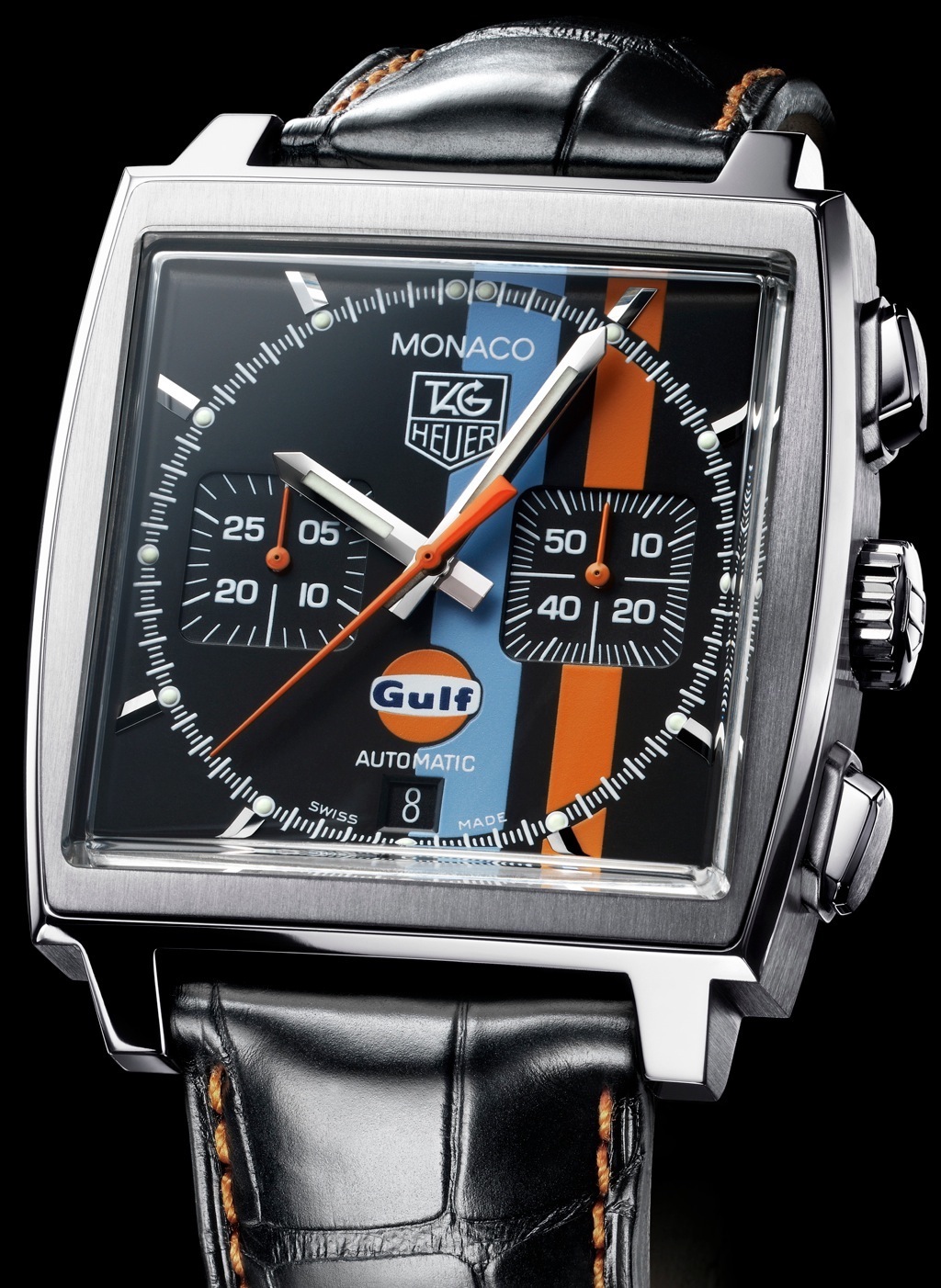
The second iteration was the Gulf II Monaco ref. CW211A which was technically the same as its predecessor but with a new dial. Now black with orange and blue, it was an homage to McQueen’s Gulf Oil Porsche 911 in Le Mans. It also features the Gulf logo on the dial, with the ‘Monaco’ text moved to 12 o’clock. As with the CW2118, this Gulf II Monaco came in a limited edition run of 4,000 units. These are harder to find than the white-dialed version, likely because the black dial just looks better. There are a few units available (current listings here) ranging between $3,500- $6,500.
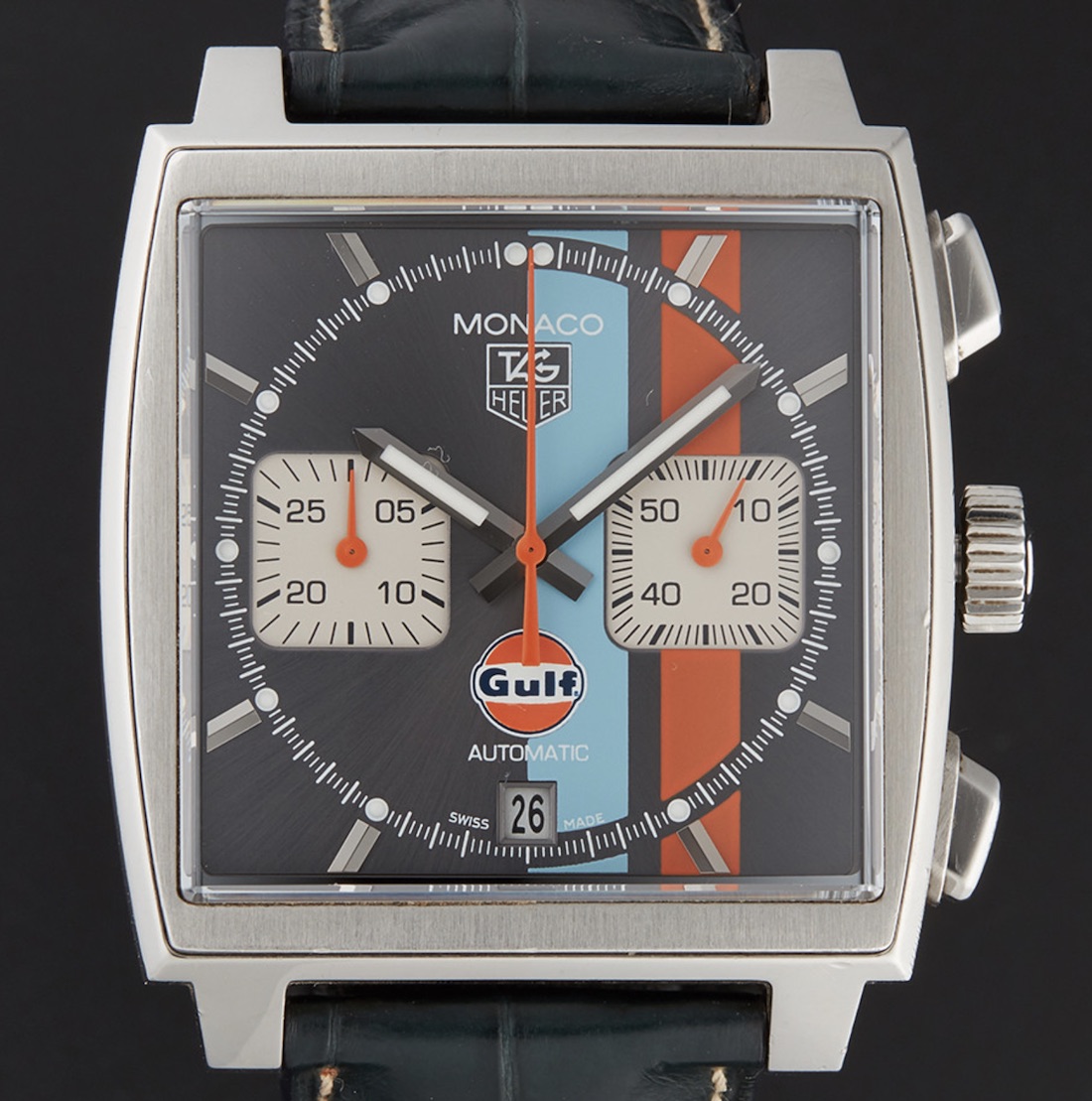
TAG Heuer Monaco Gulf CAW2113 Calibre 12 (2009)
Two years later saw the limited edition Monaco Gulf ref. CAW2113 with some aesthetic changes as well as a new case and new movement.
The new dial swapped out the black dial for a metallic grey with blue/orange stripes while quizzically also replacing the black date window. They replaced the matching black dial with a white date window rather than having it match the grey dial. The change from the calibre 17 to the calibre 12 wasn’t really that big of a deal. It did mark the use of a Dubois-Depraz chronograph module rather than an ETA chronograph module.
The new case size here grew by 1mm to 39mm x 39mm and 14mm thick with an exhibition caseback. Another limited edition run of 4,000 units, the then-updated CAW2113 seems to fetch around the same prices as the first two Gulf Monacos (listings right here) with about a dozen available units between $4,000-$6,500.
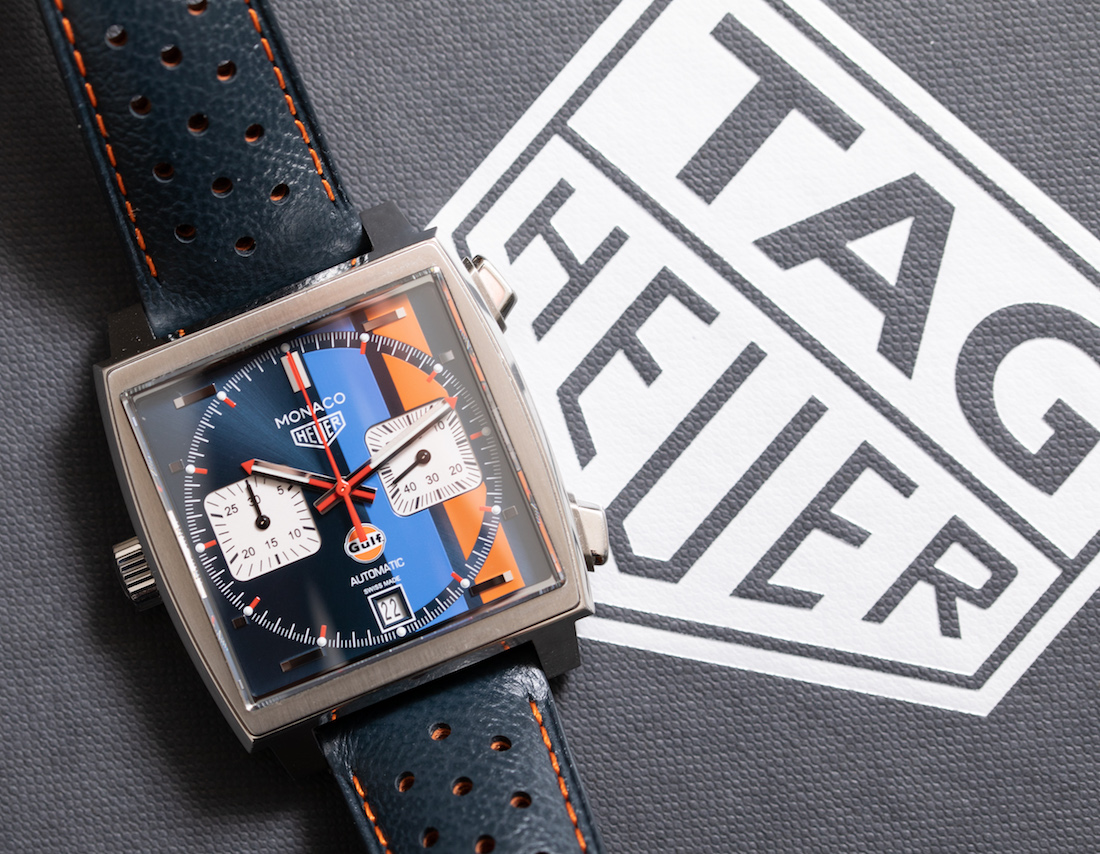
TAG Heuer Monaco Gulf CAW211R Calibre 11 (2018)
After 9 years, we reach the watch I discuss now. There are a few refinements that I think make this the most wearable and best looking modern Monaco (alongside its classic blue cousin). The square case of the Monaco has always been its most easily identifiable and noticeable feature. It’s actually pretty impressive how a square watch, with the crown on the right side of the case and chronograph pushers on the left side, a high raised box sapphire crystal, and a blue/orange dial manages to not at all feel like it’s “too much” in any way.
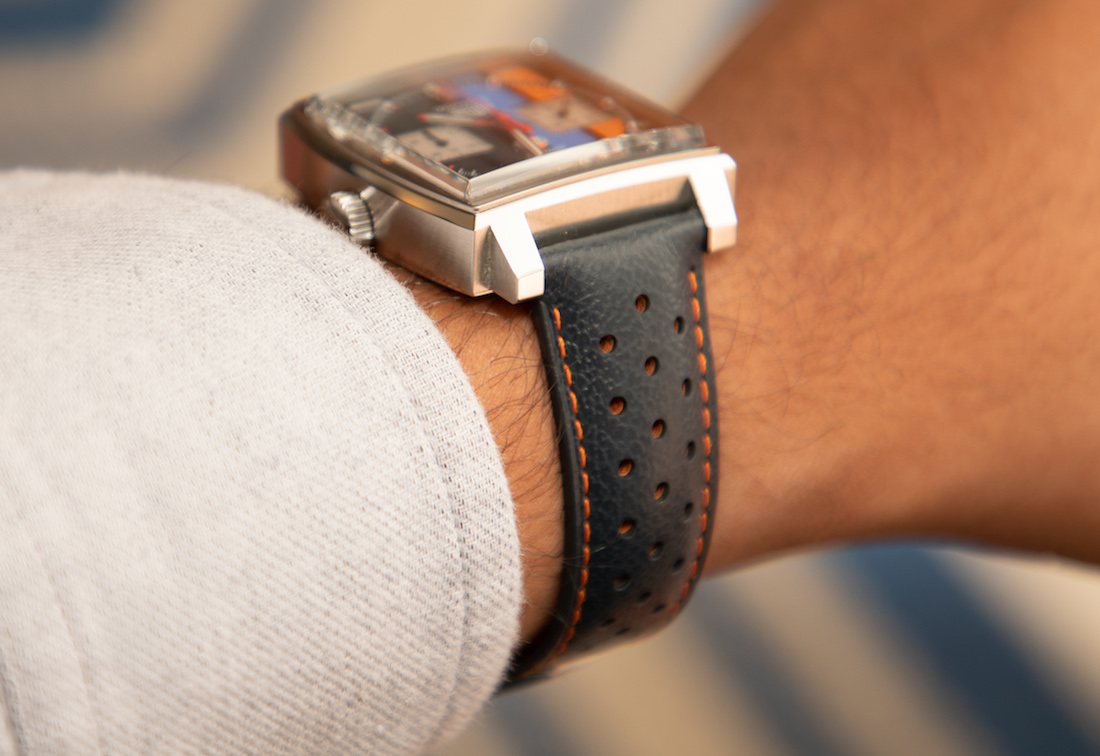
The 39mm x 39mm case is a perfect square, with short lugs and 47mm lug to lug. When you factor in the crystal, the case thickness is right around 15mm. There are straight lines but the slightly cushioned case shape goes a long way. Mostly, in not making it feel like there is a box on your wrist.
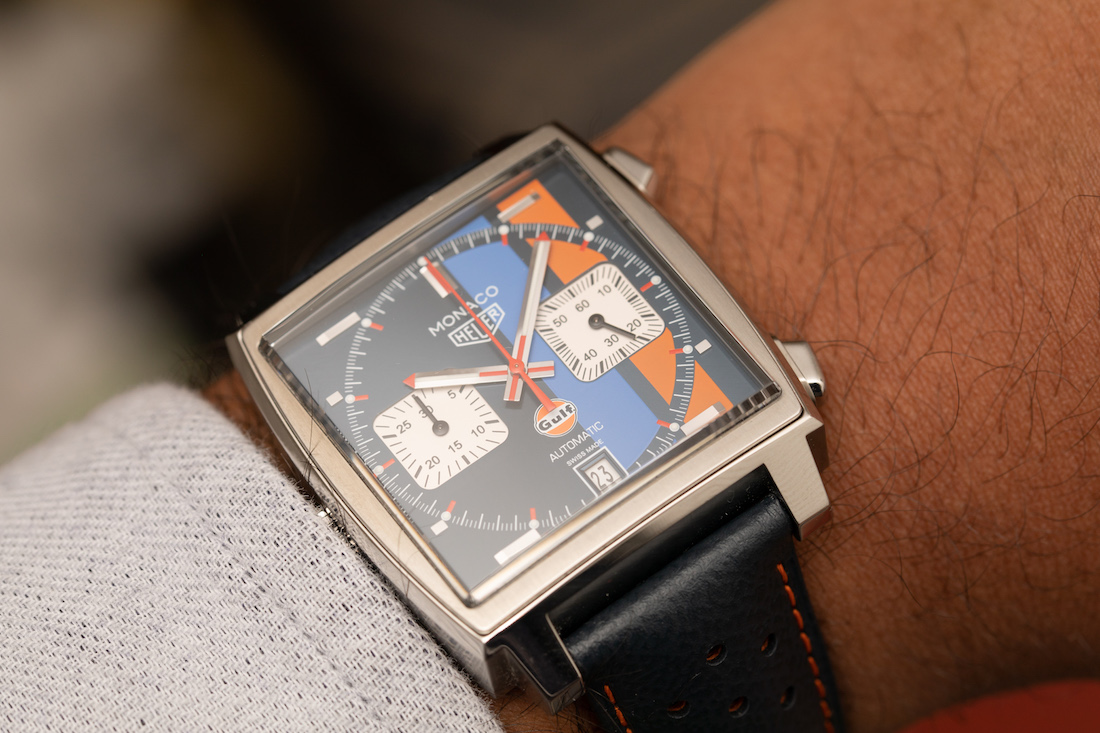
The dial is laid out like the standard Monaco Calibre 11, albeit with the Gulf color scheme. At 9 o’clock is the 30-minute chronograph counter and at 3 o’clock is the running seconds sub-dial. I won’t get into detailing each aspect of the sunray brushed dial here since there is so much content already written about the Monaco. It really comes down to loving the case and the Gulf Oil color scheme in this watch.
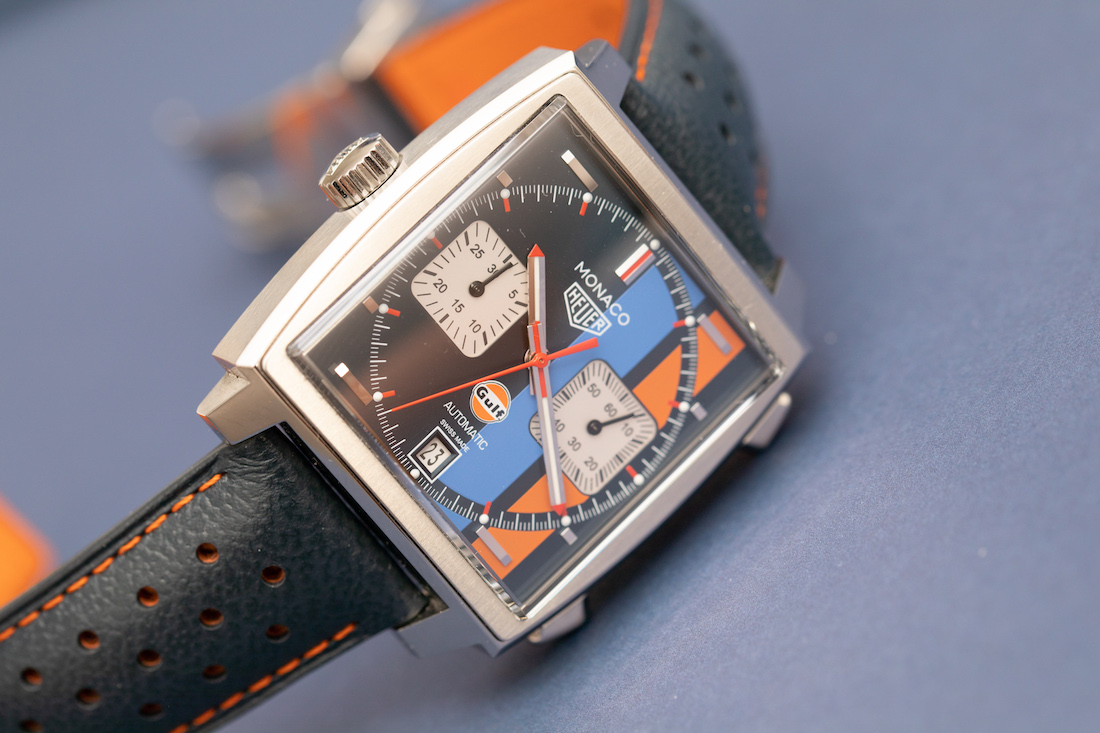
What I do think ties the whole package together here is the strap. A simple perforated blue calfskin strap with orange stitching, I can’t imagine a better choice here. The leather on the strap is firm without being rigid, feels and looks high-end but still sporty, and is easily adjusted by way of the double safety push buttons on the folding clasp. It’s very similar to the strap on the standard Monaco Calibre 11, but I do want to give TAG Heuer credit for abandoning the alligator straps that all the previous Gulf Monaco watches came on. They just didn’t match the watch at all, in my opinion.
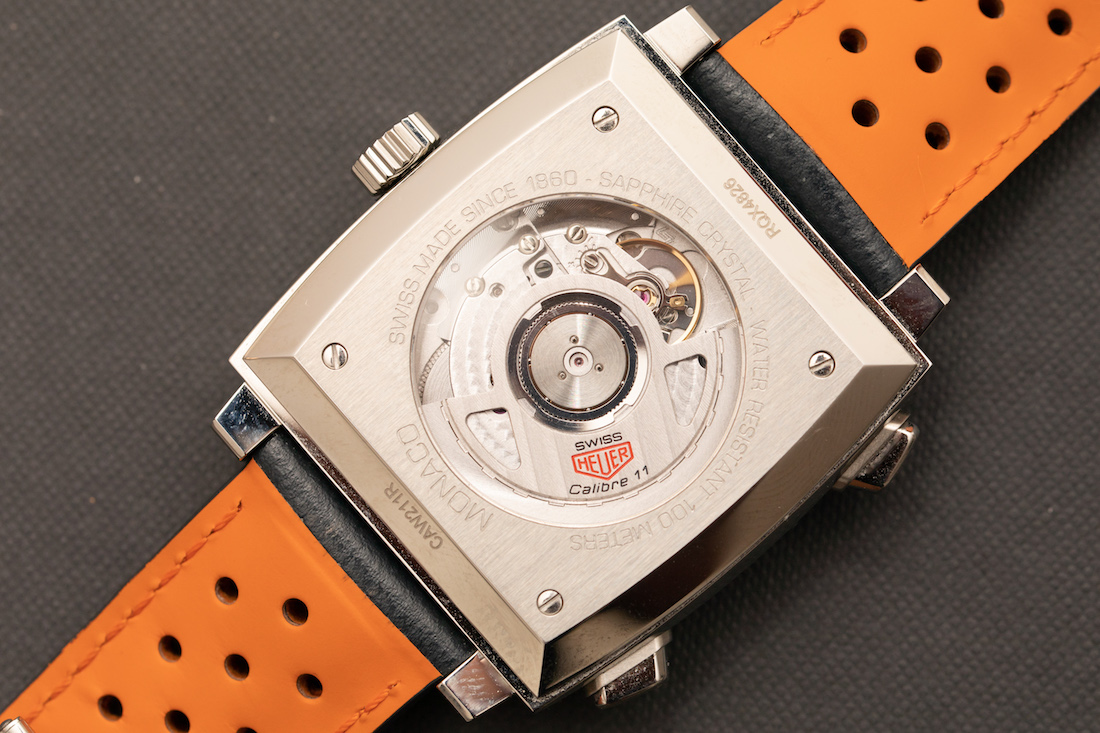
TAG Heuer Monaco Gulf Calibre 11 movement (Old & New)
It’s not news at this point, but I want to touch on the Calibre 11 movement. This is because the original 1969 Calibre 11 is a classic movement, which was a joint effort between Heuer, Breitling, Büren, and Dubois-Dupraz. Most people will know it as being one of the first automatic chronographs, an honor that watch enthusiasts can’t quite find consensus on between the Heuer Calibre 11, the Zenith El Primero, and Seiko’s 6139A.

The original Monaco used the original Caliber 11, which just happened to be the first square-cased automatic chronograph. Oddly, TAG Heuer used the same name for the Calibre 11 used in the Monaco Gulf. Putting aside nomenclature wisdom, the Calibre 11 is visible through the exhibition caseback. It’s a good looking movement and one that has proven itself worthy of the name in the few years it’s been around. It’s a modified Sellita base movement with a Dubois-Depraz module resulting in a movement that operates at 28,800 vph, has a 40-hour power reserve, and of course, allows for the crown on the left side of the case.
